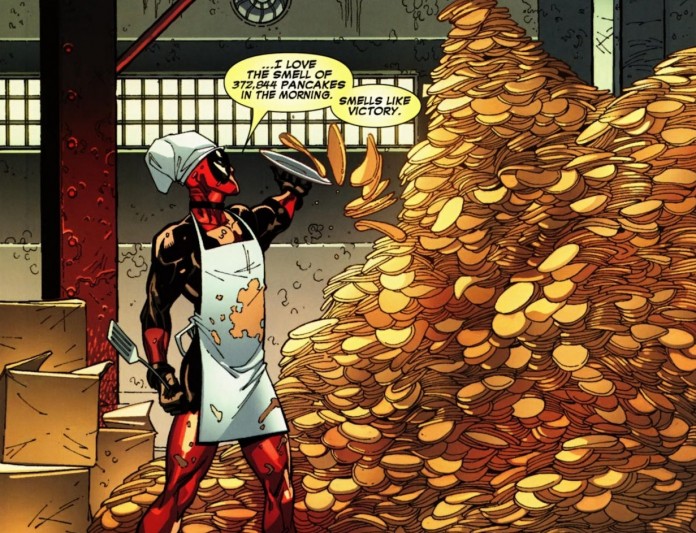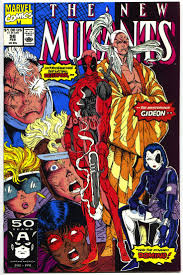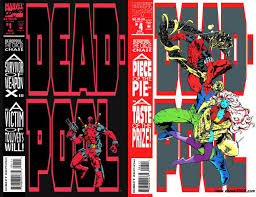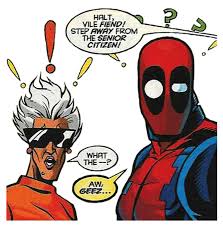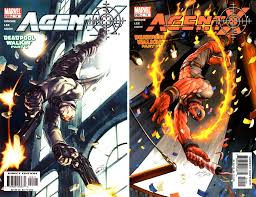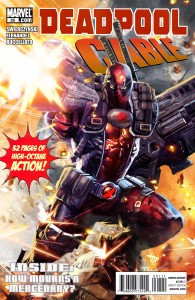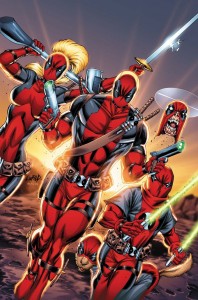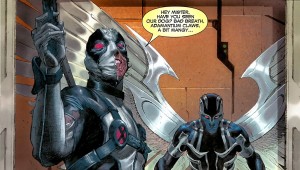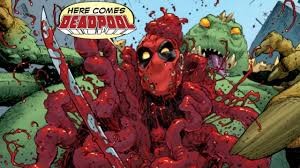Alright, motherlovers, it’s time to get knee deep in the naughty. Love him or hate him (and most of you love him) no one can deny that Deadpool has been one of the most important comic characters of the past quarter century. Go on; name me one mainstream comic character created after the Silver Age that has as much cultural penetration as Deadpool. Wolverine? OK, you got me there. Punisher? Alright, there’s another one. Give me a third. You can’t right? Because there isn’t one.
Deadpool gear is everywhere. Shirts, hats, kicks, you can’t swing a dead and dismembered mercenary without hitting someone rocking some fresh Deadpool gear. You know why? Because people love Marvel’s Merc With a Mouth. In fact, other than Wolverine and Punisher, Deadpool might be Marvel’s most important creation in the post-Silver Age era. He’s starred in a ton and a half of comics, is a merchandising king, and now has a movie that is buzzing very loudly amongst hardcore comic fans and mainstream audiences alike. Why do you suppose that is? Maybe it’s because everyone loves a smart ass. An ultra-violent dude with testies made of hand grenades that is not afraid of standing up to the D-bags of the world with a wink and a smile. Really, Deadpool is like Marvel’s version of Bugs Bunny. But with stabbing. And dick jokes. And seeping exit wounds. And really who doesn’t love Bugs Bunny?
So Deadpool is crazy popular but how many people know the history of Marvel’s Merc with a Mouth? Well, pull up a stool son, we are here to educate you on the history of Marvel’s most important wiseass (other than Spider-Man, the Human Torch, and Iceman), Deadpool!
Ironically, Deadpool become insanely popular despite the fact that originally the character was simply a parody of one of Marvel’s publishing rivals. In the 80s and into the 90s, the New Teen Titans were a pretty big deal over at DC. The Titans’ greatest enemy (and a name that should be very familiar to fans of the CW’s “Arrow”) was the morally complex evildoer Slade Wilson aka Deathstroke aka The Terminator. You know a villain is badass when he has three names. When writer Louise Simonson followed by Fabian Niciezia and artist Rob Liefeld all took over Marvel’s “New Mutants,” the creative trio began to introduced a ton and a half of new characters. You had Cable leading the way for Domino, Shatterstar, Feral, Stryfe, the fifteen thousand new villains that made up the Mutant Liberation Front, Gideon and his Externals, and probably a bunch I’m forgetting. Within this unprecedented burst of creative output, Niciezia and Liefeld sprung a character very similar to Deathstroke on the world. Get it, Wade Wilson instead of Slade Wilson. Deadpool, Deathstroke. Yeah, it was all very silly and who could have ever thought that this little bit of fun meant to poke at DC Comics would have staying power. But man, did it.
If one reads those early issues of “New Mutants” and later “X-Force,” one will find that those issues were a bit teeth gnashy . The book was ultra serious with lots of big guns, sharp swords, and ‘splosions and there really wasn’t much room for the yucks. Enter, Deadpool. In “The New Mutants” #98 (February 1991), Niciezia and Liefeld presented Deadpool for the first time. In this issue (which now goes for big bucks by the way), Deadpool went up against Cable and his cadre of young mutants. While Cable scowled, Deadpool laughed and was a breeze of levity blown into the dark world of early 90s mutant drama. He was introduced as a villain, but it wouldn’t be long before Deadpool would evolve into the very complex and very silly anti-hero that has taken pop culture by storm.
In his first appearance, Deadpool was hired by the villainous Tolliver to take down Cable and his New Mutants. When the New Mutants evolved into X-Force, Deadpool was there to make a nuisance of himself. While he was a pain the nut sack, Deadpool always provided X-Force with all they could handle and more. But where did this hilarious but deadly merc come from? Over the years, Marvel readers have gotten glimpses into Deadpool’s past. It has been hinted that it is all a lie, a product of Wade Wilson’s twisted imagination, but here are some interesting little tidbits for those curious about the origins of Deadpool.
By all accounts, Wilson’s mother died of cancer and his father was a physically abusive brute. One night Wilson stole his father’s hand gun and murdered the jerkoff. Finding he had a taste for killing, Wilson began to lead a mercenary life. Even as a teenager, Wilson took on a number of high profile assassination assignments and became somewhat of a wet works legend. His activities brought Wilson into contact with a prostitute named Vanessa Carlysle, who he fell in love with. Tragically, Wilson contracted a rare form of cancer and left Vanessa so she wouldn’t be forced to watch him slowly wither and eventually die because no man wants his best girl to see him poo himself to death.
Desperate for a cure, Wilson joined up with Department H. Now, for you newbies, Department H was also responsible for the creation of Wolverine so they are kinda important to X-Men lore. Department H injected Wilson with a derivative of Wolverine’s healing gene which gave the dying mercenary a new lease on life and a fast acting healing factor. So now, Wilson was a piece of banana nut bread that could not die. He became a Department H operative along with his fellow mercenaries Slayback and Kane and a bunch of other dickheads with very 90s names. At this time it was also revealed that Vanessa had shape shifting powers and she joined the team as Copycat. Now, one wonders if the “Deadpool” film will tie Wilson’s origins into the origins of Wolverine because that would be all sorts of cool.
Fans didn’t know all this when they first met Wilson in “New Mutants” #98, but as time went on, this and so much more was revealed to Deadpool’s ever growing fanbase. After his first appearance, Deadpool returned to annoy and challenge X-Force a number of times and also made a general nuisance of himself all around the Marvel Universe. In “X-Force,” Deadpool reunited with Vanessa (who was posing as Domino), went up against Slayback, and began to develop a crush on X-Force’s Siryn. The character was gaining quite a cult following, so Marvel gave Deadpool his own mini-series in 1993 entitled “Circle Chase.” This series featured stunning art by Joe Madureira and went a long way in establishing Deadpool as so much more than just a wacky satirical version of Deathstroke. In “X-Force,” Niciezia began to pepper in some real characterization for Deadpool and he followed up on this development in the pages of the first (of MANY) “Deadpool” series. In this first mini, Niciezia began to introduce some tragic elements in Deadpool and also began to dig under the slapstick surface to find the man within. Now, Deadpool was so much more than the agent of extreme killing machine he was introduced as. After “Circle Chase,” what started out as a parody became a real viable character and one assumes that many of these elements introduced by Niciezia in 1993 will make their way into the film version of “Deadpool.” Mark Waid and Ian Churchill presented a follow up miniseries in 1994, as Marvel continued to make Deadpool so much more than just an extreme punch line.
Picking up the narrative ball and running with it, writer Joe Kelly and artist Ed McGuinness began a run on “Deadpool” that would become one of the most beloved runs on the character and one of the most beloved runs of any comic during the uneven and turbulent 90s. Kelly and McGuinness continued to establish Deadpool’s supporting cast with his mentor figure Blind Al and his best buddy Weasel. Both these players will contribute majorly to the upcoming film. Kelly and company also established a rogues gallery for Wilson most notable of which was T-Rex, a character that would go on to become Deadpool’s greatest foe. Make no mistake, these issues were hilarious with Kelly and McGuinness providing some of the best timed humor in mainstream comics, but they were also tending the garden that Niciezia planted and taking Deadpool from one note joke to rich and diverse character.
Over the years, Deadpool has had some truly innovative storytelling devices thrust upon him by his creators. Deadpool frequently breaks the fourth wall and has two (and sometimes three) running narration boxes. Deadpool has always been as experimental as he has been fun and this has gone a long way in explaining Deadpool’s long term popularity.
Somehow, Kelly managed to balance a scathing satirical edge to go along with the character’s innate angst, and by the time Kelly exited the book, Deadpool had fully transformed from troublemaking villain into bona fide anti-hero.
After Kelly departed, Christopher Priest took over the writing chores and continued Deadpool down that metafictional, fourth wall breaking path, but interest in the character had waned a bit after Kelly’s exit and Deadpool’s first series came to an end. Always tricksie, Deadpool pulled the wool over everyone’s eyes in 2002’s “Agent X” series. Written by the great Gail Simone, “Agent X” featured a mercenary named Alex Hayden who everyone assumed was Wade Wilson with amnesia. It turned out it wasn’t, and Deadpool returned with a vengeance. “Agent X” was a unique little footnote in Deadpool history and I’m surprised no writer has brought Alex Hayden in some capacity.
Deadpool’s next starring role was in “Cable & Deadpool” by original Wade Wilson creator Fabien Niciezia, This saw Wilson team up with his old enemy Cable and the two became one of the favorite buddy pairings in modern Marvel history. This book thrust good old Wade into some truly big concept sci-fi adventures showing the narrative malleability of the character. But even with the super serious Cable by his side, Deadpool was still as zany as ever in this cult classic series.
Deadpool followed up his Cable team up book with his second monthly series, and this time, Deadpool mania truly ran unchecked throughout comicdom. Under the auspices of writer Daniel Way, Deadpool was taken on a monthly tour of the Marvel Universe, butting heads and lighting farts with some of Marvel’s most iconic characters. This book proved to be a hit and the marketing machine began.
Quicker than a chimichanga runs through the bowels of a ninety year old, Deadpool was suddenly all over the Marvel Universe. A second monthly followed with “Deadpool: Merc With A Mouth,” followed by a hilarious hero mash up entitled “Deadpool Team Up.” It seemed like Deadpool could star in any type of story from a wacky self referential parody story to a super serious super hero saga. Soon, Deadpool was spun off into “Deadpool MAX,” a rated R take on Marvel’s kookiest killer. This is important to note because of the recent controversy surrounding the R rating of the upcoming “Deadpool” film. Many want “Deadpool” to be PG-13, and truly, that’s the rating Marvel has slapped on “Deadpool” all these years. Through all the beheadings, strangulations, fart jokes, bowel explosions, and eye skewering, “Deadpool” has always managed to float in under R, except for this “Deadpool MAX” series.
Deadpool mania didn’t stop with this series of books, oh no. Because Deadpool has always been an anything goes character, Marvel got really wacky with the world of Wade Wilson. Soon, fans were introduced to Headpool, a talking Wade Wilson head from the Marvel Zombie Universe, Lady Deadpool, Dogpool, Kid Deadpool and many more. It never got overly silly because it was always meant to be wacky fun as Deadpool was taken in every story direction Marvel’s creators could dream up.
While concepts like Dogpool were able to come to fruition, Marvel also positioned Deadpool in some major mainstream comics. Wade Wilson joined a very new X-Force as writer Rick Remender found ways that the always humorous Wilson could participate in some truly epic storytelling. In the pages of this new X-Force, Deadpool and his teammates (which included such A list mutants as Wolverine, Psylocke, and Archangel) went up against such villains as Apocalypse, Kang, and many more big bads that were in no way wacky. Meanwhile, in the pages of his own book Deadpool was taking on the likes of Dr. Bong proving that Deadpool was comfortable taking part in any type of comic tale.
Recently, Deadpool has been starring in a monthly comic by Gerry Duggan and comedian Brian Posehn. In the pages of this title, Deadpool has gone up against zombie residents, pimps, and other concepts that could only work in a comic starring Deadpool. Wilson has also taken another great heroic step by becoming a legit, for real Avenger. That’s right, in the pages of “Uncanny Avengers,” Wade Wilson has become one of Earth’s mightiest (and most flatulent) heroes. And for those of you who loved or are curious about Joe Kelly and Ed McGuinness’ run on “Deadpool,” the classic creative team recently launched a “Spider-Man and Deadpool” team up book that rekindles some of that old ‘pool magic from back in the day.
It truly is a great time to be a Deadpool fan. For years, disciples of Wade Wilson have dreamed of a film that would do Deadpool justice, and it looks like they will soon be getting it. So if you are new to Deadpool or excited for the upcoming film, check out some of the comics mentioned in this article, we promise the laugh quotient and body count will both be high!

